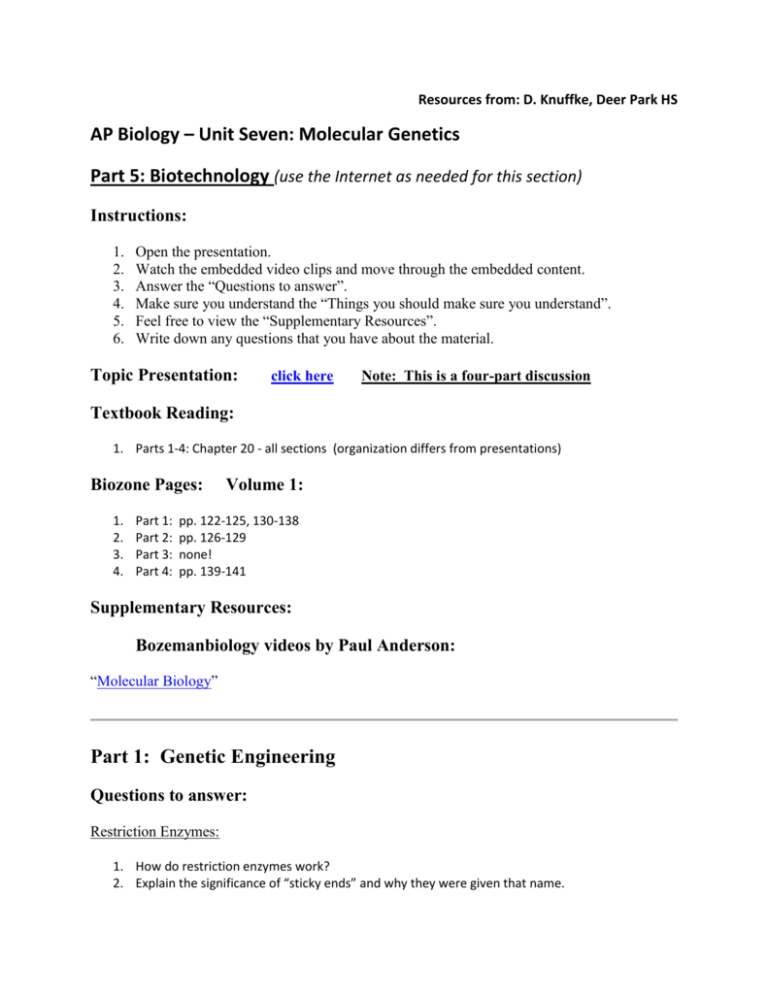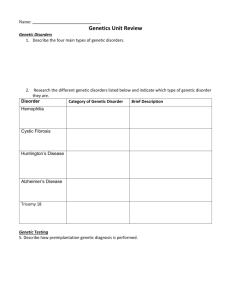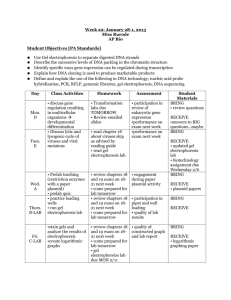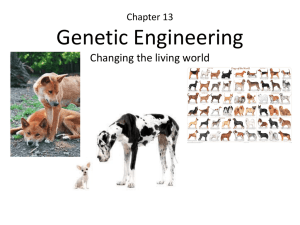AP Biology: Biotechnology Worksheet - Genetic Engineering
advertisement

Resources from: D. Knuffke, Deer Park HS AP Biology – Unit Seven: Molecular Genetics Part 5: Biotechnology (use the Internet as needed for this section) Instructions: 1. 2. 3. 4. 5. 6. Open the presentation. Watch the embedded video clips and move through the embedded content. Answer the “Questions to answer”. Make sure you understand the “Things you should make sure you understand”. Feel free to view the “Supplementary Resources”. Write down any questions that you have about the material. Topic Presentation: click here Note: This is a four-part discussion Textbook Reading: 1. Parts 1-4: Chapter 20 - all sections (organization differs from presentations) Biozone Pages: 1. 2. 3. 4. Part 1: Part 2: Part 3: Part 4: Volume 1: pp. 122-125, 130-138 pp. 126-129 none! pp. 139-141 Supplementary Resources: Bozemanbiology videos by Paul Anderson: “Molecular Biology” Part 1: Genetic Engineering Questions to answer: Restriction Enzymes: 1. How do restriction enzymes work? 2. Explain the significance of “sticky ends” and why they were given that name. Vectors: 3. Diagram a typical designed plasmid vector. Label and define each of the following parts: a. the ori b. the multiple cloning sequence (you might need the internet) c. selectable markers--give two examples of genes used as selectable markers. Genetic Engineering: 4. How does bacterial transformation work? What do bacteria use it for? What do genetic engineers use it for? 5. What is cDNA? How is it made? Why is it necessary? 6. Diagram the process of genetic engineering a bacterium. a. b. c. d. e. Begin with a plasmid and the gene of interest. Show how the gene is inserted in the plasmid. Show how the plasmid is incorporated into a bacterial cell. Show how the cell copies the plasmid. Show how the cell expresses the gene of interest. 7. Explain how reporter genes (selectable markers) can be used to separate bacteria who have taken up the transformed plasmid from those who have taken up the non-transformed plasmid. Things you should make sure you understand (feel free to ask questions about them in class): 1. 2. 3. 4. 5. 6. 7. 8. How restriction enzymes evolved. The use of restriction enzymes in genetic engineering. The use of vectors in genetic engineering. Why bacterial cells are comparatively easy to genetically engineer. How ligase is used in genetic engineering. How reporter genes like LacZ and Green Fluorescent Protein are used in genetic engineering. How genetically engineering eukaryotes differs from genetically engineering prokaryotes. How genetically engineering complex (multi-gene) traits differs from genetically engineering simple (single-gene) traits. Part 2: Genetic Testing Questions to answer: Gel Electrophoresis & Labeling: 1. How does gel electrophoresis work? What properties of the DNA does it utilize? 2. Where will the smallest fragments of DNA be found on a gel after it runs? Where will the largest fragments be found? How is the size of a particular fragment determined? 3. Why is it necessary to utilize probes for labeling particular DNA sequences? How is this process accomplished? The Polymerase Chain Reaction: 4. Explain the purpose of the Polymerase Chain Reaction. Why is it useful? 5. Explain the function of the following in PCR a. Taq polymerase b. primers. c. thermal cycler. 6. Explain what happens during each phase of a PCR cycle, and the temperature at which each phase occurs: a. Denaturation b. Annealing c. Elongation. Genetic Testing: 7. Explain the relationship between single nucleotide polymorphisms (“SNPs”) and restriction fragment length polymorphisms (“RFLPs”)? How are they caused and why do they matter? 8. Pick one real-world application that uses PCR and gel electrophoresis and specifically explain how each process is used in that application Things you should make sure you understand (feel free to ask questions about them in class): 1. How gel electrophoresis is used in genetic engineering. 2. How PCR is used in genetic engineering. 3. The ethical considerations involved in genetic testing. Part 3: Cloning & Sequencing Questions to answer: Cloning: 1. Compare and contrast therapeutic cloning with reproductive cloning. DNA Libraries: 2. What is the purpose of a DNA “library”? How can specific genes be retrieved from a DNA library? DNA Sequencing: 3. What are dideoxynucleotides? Why are they used in DNA sequencing? 4. Explain how the Sanger sequencing method works. 5. How has sequencing technology advanced since the development of the process by Fred Sanger? Give three examples. Microarrays: 6. What is the purpose of a microarray? Give an example of a real-world application of microarray analysis (you probably need to use the internet). Things you should make sure you understand (feel free to ask questions about them in class): 1. The ethical considerations involved in reproductive and therapeutic cloning. 2. How DNA sequencing is used in genetic engineering. Part 4: Ethical Considerations Questions to answer: 1. Give three examples of things that the biotechnology revolution has allowed us to do that couldn’t have been done at a prior point in human history. You will most likely need to do a bit of research to answer these questions: 2. From a legal standpoint, how much information do you have a right to know about the genetically engineered nature of the food you eat and the products that you consume? 3. From a legal standpoint, how much information do other people and entities have the right to know about your genome? 4. From a legal standpoint, what sorts of genetically engineered technologies are individuals allowed to copyright? 5. From a legal standpoint, what constraints are placed on the scientific establishment with regard to altering the genetic material of organisms? This one is for your own consideration: 6. Consider the answers to the last five questions. From a personal moral/ethical standpoint, how do you feel about those answers?










